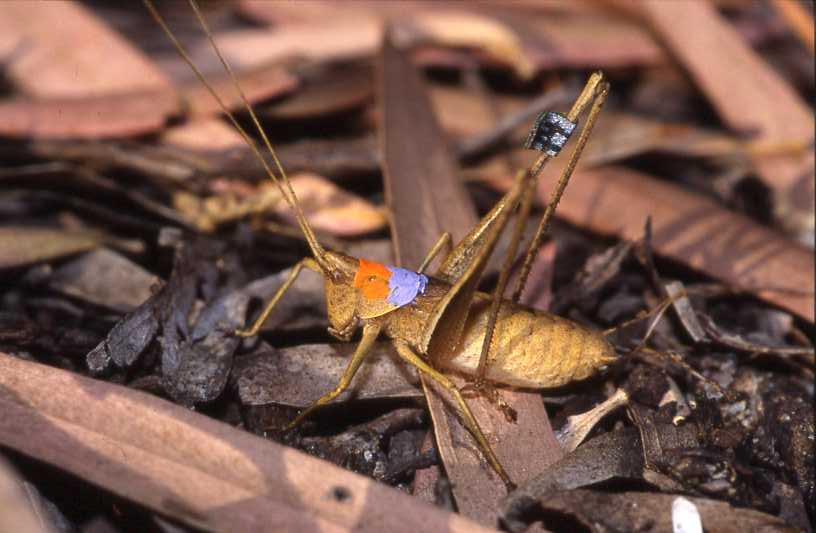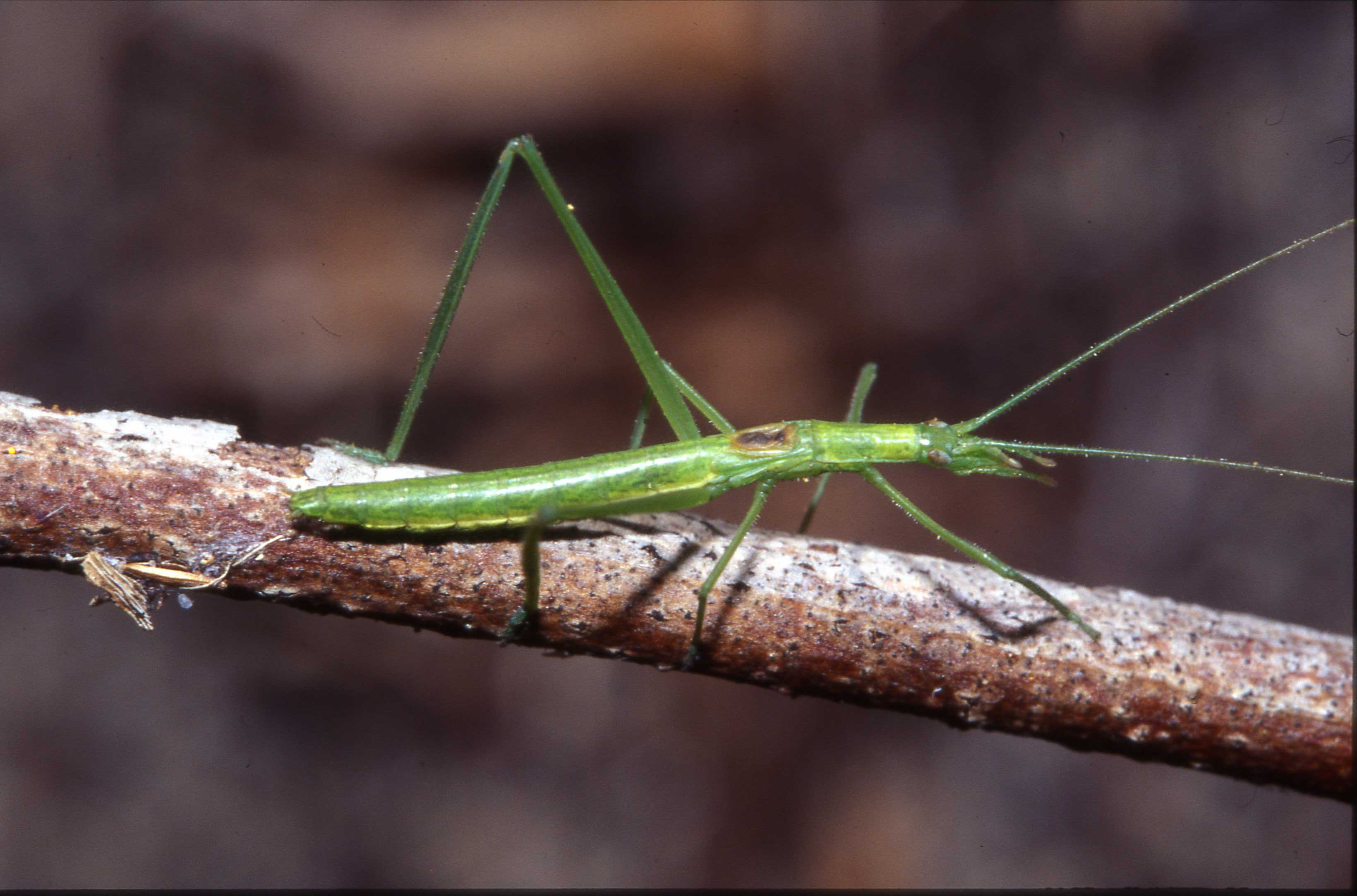 |  |
Behavioural Physiology, Behavioural Ecology, Acoustic Communication, Mating systems: especially nuptial gifts, autonomous Acoustic monitoring of biodiversity
Behavioural experiments, bioacoustic, neurophysiology and neuroanatomy, isotope analysis
Model organisms: Insects: bushcrickets (Ensifera: Tettigoniidae), grasshoppers (Caelifera), acoustic orienting parasitoid flies (Tachinidae: Ormiini)

Xederra charactus male marked for experiment (used for Lehmann 2007)

The tiny australian Kawanaphila mirla - a green male (see Lehmann and Lehmann 2007)
Neurophysiology and neuroanatomy of hearing in bushcrickets
The bushcricket genus Poecilimon is species-rich and contains more than 120 named species in the Western Palaearctic Region. As common in the whole subfamily of Phaneropterinae, most species have a bidirectional communication system: males produce calling songs, which are replied by their females with own, short response songs. Independently, several species have returned to an unidirectional mode, in which the silent females lost their ability to sing. The morphological arrangement of the nerve cells in the hearing organ "Crista Acustica" is highly variable between species (Strauß et al. 2012). Furthermore, the neurophysiology and neuroanatomy of the hearing organs are altered in line with the changes in the communication system (Strauß et al. in prep.).
Unisexual reproduction is a rare but widespread phenomenon in invertebrates and lower vertebrates. This holds true even for bushcrickets, were only few cases of obligate dipoloid parthenogeny are known (Lehmann et al. 2010b). Traits under relaxed selection are expected to become reduced or disappear completely, a process called vestigialization. The bushcricket Poecilimon intermedius is one of the few insect species with obligate but diploid parthenogenetic reproduction.
Compared to its sister-species P. ampliatus, the morphology of the hearing organs (acoustic spiracle, crista acustica) and the function of hearing (acoustic threshold) are reduced. Nonetheless, hearing is clearly maintained in the parthenogenetic females. Natural selection by acoustic hunting bats, pleiotropy or a developmental trap may explain the well maintained hearing function (Lehmann et al. 2007).
In cooparation with Dr. Johannes Strauß, Justus-Liebig-Universität Gießen.
Longtime monitoring of biodiversity using autonomous acoustic sensoring systems (EU Project AmiBio)
The AMIBIO project aims to construct and deploy autonomous multi-sensor monitoring stations and to automatically analyze their transmitted measurements for long-term monitoring of biodiversity activity trends in the region of the Hymettos, Greece. Within this EU financed Life+ project we monitore the occurence of acoustically active birds, mammals and insects in the Natura 2000 area Hymettos, east of Athen, Greece (Jahn et al. 2011, 2012; Lehmann et al. in prep.). 16 remote monitoring stations sample the acoustic activity of the animals. All stations are solar powered and transfer their data to a central computer. This allows for cost effective monitoring of biodiversity data. The software for automatic species identification is under way. We also hope to improve databank management acoustic biodiversity data within the framework of this project.
The project is part of the EU initiative Natura 2000, to safeguard Europe's rich diverse natural habitat.
In cooparation with Zoologisches Forschungsmuseum Alexander-König, Bonn, University of Patras, University of Athens, SPAY: Association for the Protection and development of Hymettos.
We study the patterns of chromosome evolution in the European bushcrickets of the subfamily Phaneropterinae using classical NOR- as well as FISH-staining (Warchalowska-Sliwa et al. accepted). The data on chromosome modifications are compared with a molecular phylogeny of the group. Studying the southwest Mediterranean genus Odontura in more detail, we found an intensive evolution of the karyotype, both in terms of changes in the number of chromosomes and the sex chromosome system. The basical pattern is an XX-sex determination in females and X0 in the heterogametic males. However, males of two species have evolved a Neo-XY or a neo-X1X2Y pattern in their sex chromosomes (Warchalowska-Sliwa et al. 2011; Grzywacz et al. 2). This new evolved sex chromosomes in the males can be expected to have fundamental consequences for sex-chromosomal inherited traits as well as selection due to mate choice.
In cooparation with Prof. Dr. Elzbieta Warchalowska-Sliwa and Dr. Beata Grzywacz, Polsih Academy of Sciences, Poland.
Nuptial gifts
In bushcrickets, males transfer a nuptial gift during mating. This spermatophore works as sperm protection device and at least sometimes as parental investment (Lehmann 2012). Ingredients in the spermatophore are incorporated into the somatic tissue by females (Voigt et al. 2006) and fuel the female metabolism (Voigt et al. 2008).
Heavier males of Poecilimon zimmeri transfer larger spermatophores (Lehmann and Lehmann 2009) and females exhibit clear choice for heavier males in mating trials (Lehmann and Lehmann 2008a). Such preferences for heavier males reflects a female's preference for a larger spermatophore and therefore for a greater direct benefit.
In line with the hypothesis that spermatophore production is costly, we found that spermatophylax weight was reduced in parasitized bushcricket males (Lehmann and Lehmann 2000a). Parasitized males with a smaller spermatophylax induced a reduced refractory period in females. During this shortened period fewer eggs were deposited, as an effect of the shorter refractory period, whereas the daily egg-laying rate remained the same (Lehmann and Lehmann 2000b).

Parasitoid flies - Ormiini
Tachinid flies of the tribe Ormiini possess a conspicuously inflated prosternal region, enabling them to detect the mating songs of their hosts. The only European Ormiini representative, Therobia leonidei, attacks the singing sex of three different families of bushcrickets (Lehmann 2003, Lehmann 2008). In populations of the Greek phaneropterine bushcricket Poecilimon mariannae males, which produce long calls, were found to be parasitized in large proportions. In contrast, Poecilimon veluchianus produces short calls and is less parasitized (Lehmann and Heller 1998), proving that longer songs are easier to detect. Moreover, male calls that are more attractive to females are also more attractive to parasitoid flies (Lehmann et al. 2001), suggesting a trade-off between sexual and natural selection.
These flies lay their larvae on or near males; the larvae burrow into the cricket’s body, feed on the tissue and kill the animal upon emergence (Lehmann 2006). Developing fly larvae reduce male bushcricket survival and reproductive effort (Lehmann and Lehmann 2000a, 2000b). Parasitized males loose 42% of their potential lifetime reproductive success (PLRS) compared to nonparasitized males. This fitness loss is context dependent; if nonparasitoid related mortality is high, the selection on host males to avoid parasitism is weak (Lehmann and Lehmann 2006).

Opportunities for Students
Students are welcome to do their degree projects (Diploma, Bachelor, Master or PhD) in the Department of Biology. Potential students are encouraged to take part in ongoing research projects. However, I am willing to discuss independent ideas. Those who are interested are advised to contact me at gerlind.lehmann (at) t-online.de
Students
Kuchenreuther, Sina (current) Bachelor-Arbeit Humboldt-Universität zu Berlin.
Polz, Anne (current) Master-Arbeit Humboldt-Universität zu Berlin.
Wulff, Nadja C. (2013) Die Bedeutung von internen Genitalien bei der Laubheuschrecke Metrioptera roeselii (Orthoptera: Tettigoniiidae): Verankerung oder Stimulationsorgane? Master-Arbeit Humboldt-Universität zu Berlin.
Erzberger, Anna (2010) Using stable hydrogen isotope analysis to estimate altitudinal migration of bats in Cusuco National Park, Honduras. Bachelor-Arbeit Humboldt-Universität zu Berlin. - Published as Erzberger et al. (2012).
Jaszkowiak, Katja (2010) Balanzierter Farbpolymorphismus bei der Feldheuschrecke Chorthippus dorsatus. Bachelor-Arbeit Humboldt-Universität zu Berlin.
Portsch, Anja (2010) Trade-off-Effekt zwischen Flügellänge und Fitness bei makropteren und meiopteren Morphen von Tetrix subulata. Diplomarbeit Freie Universität Berlin. - Published as Steenman et al. (in press; under review)
Schultner, Eva (2008) Ökologie, Populationsdynamik und physiologische Merkmale einer endemischen Feldheuschrecke (Acrididae) im Herault Department, Südfrankreich. In cooperation with the Locust ecology and control research unit at CIRAD. Diplomarbeit Freie Universität Berlin. - Published as Schultner et al. (2012)
Steinmetz, Frederick (2007) Untersuchungen einer neuen Heteropoda-Spezies anhand von Morphologie, Ökologie und Paarungsverhalten (Araneae: Sparassidae: Heteropodinae). Diplomarbeit Freie Universität Berlin.
Chromosomal evolution of bushcrickets (Ensifera: Tettigoniidae: Phaneropterinae)
|
| |  |








